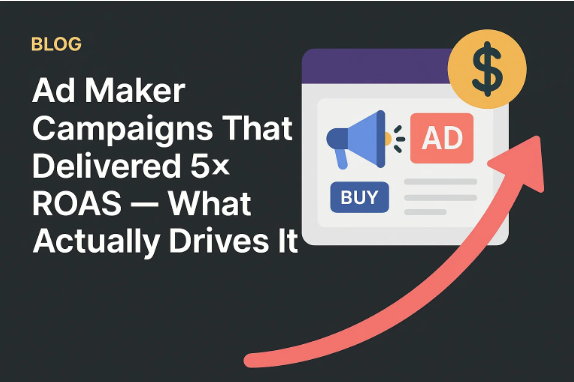Ad Maker Campaigns That Delivered 5× ROAS — What Actually Drives It.

“5× ROAS” gets thrown around a lot. The reality: it doesn’t come from one magic headline or a lucky audience—it’s the compounding effect of qualified demand, relevant creative, and tight feedback loops. If you’re using an AI ad maker, you already have the engine; this guide shows how the best‑performing accounts actually run it day to day. No fluff, just the levers that move return.
1) Start With Qualified Demand, Not Broad Reach
High ROAS starts before the first impression. Point your spend at people who are already in market or adjacent to it.
- Source signals: high‑intent search terms, pricing‑page visitors, cart revival audiences, CRM lookalikes of repeat buyers.
- Exclude early researchers (e.g., 30‑day content viewers) if ROAS is the KPI; bring them into cheaper nurture flows instead.
- Practical move: score audience pools by LTV/CAC potential, not CPM. The cheapest reach rarely returns best.
Why it works: You’re letting the algorithm hunt inside a smaller, richer pond—less waste, more conversion density.
See also: Overcoming Homeschooling Gaps: Structured Primary Online Education You Can Rely On
2) Make Relevance the Default With Modular Creative
Generic creative kills ROAS. Build a modular kit your AI ad maker can remix into hundreds of on‑brand, on‑message variations.
- 5 hooks (benefit, proof, urgency, curiosity, objection‑buster)
- 3 bodies (educational, testimonial, offer‑led)
- 3 visuals per segment (product close‑up, lifestyle context, UI/demo)
- 2 CTAs (direct vs. soft)
Rotate visuals first (fatigue hits images faster than copy), then swap hooks. Keep tone, color, and logo usage locked via brand rules so speed doesn’t break consistency.
3) Match Offer to Intent (Funnel Fit = ROAS Lift)
The right offer for the right stage matters more than clever wording.
- High‑intent searchers → price/availability, trial, consultation.
- Warm social engagers → proof and outcomes (mini case, before/after), light incentive.
- Repeat buyers → bundles, upgrades, or subscriptions.
Rule of thumb: If the click came from a “buy” moment, avoid detours (“learn more”). If it came from a “browse” moment, sell the next step, not the whole product.
4) Let Automation Move the Money (Hourly, Not Weekly)
You won’t out‑click a machine on bid edits. Turn on:
- Smart pacing: slow down when CPA rises midday; re‑accelerate when evening conversion windows open.
- Predictive budget shift: push spend to audiences/placements with rising intent (weekends, payday, seasonality) before you see the spike.
- Spend guards: pause any creative after a sensible spend with no signal (e.g., $X with 0 clicks or CTR < threshold).
What you’ll notice: fewer surprise over‑spends and more budget concentrated in hours that convert.
5) Test Fast, Cull Faster, Scale Only the Clear Winners
High‑return accounts keep tests small and decisions quick.
- Design tests to isolate learning (copy‑only vs. image‑only vs. full combo).
- Minimum data: evaluate variants after a preset floor (e.g., ≥500 imps or ≥50 clicks depending on channel).
- Auto‑rules:
- Pause <0.4% CTR at 500 imps (or your channel‑appropriate floor).
- Boost +15–25% when CTR, CVR, and CPA beat target simultaneously.
- Trigger refresh when 7‑day CTR drops ≥10% (fatigue).
- Pause <0.4% CTR at 500 imps (or your channel‑appropriate floor).
You’re not chasing perfect significance; you’re protecting budget velocity toward what works.
6) Coordinate Multi‑Channel, Keep Message Match Tight
Winners meet people where they are—without reinventing the story each time.
- Meta/IG: short, visual proof; carousel for objections; Reels for demos.
- Search/Shopping: intent capture; price, stock, and delivery speed.
- YouTube/CTV: 15–30s story for context and emotion.
- Email/SMS: reminders, incentives, and deep links.
Use the same promise, color accents, and CTA end‑to‑end. That familiarity reduces post‑click friction and boosts conversion rate—critical for ROAS.
7) Fix the Post‑Click Gap (Cheap Clicks, Expensive Bounces)
ROAS collapses when the landing page tells a different story than the ad.
- Headline match: mirror the ad’s promise in the first five words.
- CTA match: same verb, same offer.
- Proof above the fold: rating badge, micro‑testimonial, trust signals.
- Speed: keep mobile load <2s; lazy‑load below‑the‑fold.
Treat the top 600–800px like a micro landing page that resolves the click’s intent quickly.
8) Measure What Actually Protects Profit
“Great ROAS” can hide weak economics. Track the supporting metrics that keep returns real:
- Incremental lift (holdouts/geo tests) to catch attribution mirages.
- Payback window (days to breakeven) for cash‑flow sanity.
- Blended CAC across channels to avoid double‑counting wins.
- Creative decay curves so refreshes happen before returns slide.
Make go/no‑go calls using incremental ROAS and payback, not vanity spikes.
9) Guardrails That Keep You Out of Trouble
Speed is only helpful if it stays on‑brand and compliant.
- Upload brand kits (hex, fonts, logo placement) and banned phrases.
- Add claim thresholds (no superlatives, avoid regulated promises).
- Enforce frequency caps and exclusions (buyers exit retargeting within minutes).
These rails let you scale variation confidently without creating cleanup work later.
10) A Simple Operating Rhythm That Compounds
High‑ROAS teams run a boring, repeatable cadence:
- Monday – Launch a tightly scoped test set (copy or visual focus).
- Daily – Review the digest; auto‑rules handle 80%. Intervene only for edge cases.
- Wednesday – Refresh fatigued winners; spin “Gen‑2” hybrids (best headline × best image).
- Friday – Pull a two‑slide summary: what won, what lost, what we’ll test next week.
This rhythm creates a compounding advantage: every week, your baseline gets a little better.
Quick‑Start Checklist (Keep It Pinned)
- Aim spend at high‑intent pools; exclude cold researchers from ROAS campaigns.
- Build a modular creative kit and lock brand rules.
- Match offer to intent (sell the next step, not everything).
- Turn on smart pacing and predictive budget shifts.
- Test small; pause under‑performers fast, boost real winners.
- Keep message match across channels and landing pages.
- Track incrementality, payback, and decay, not just ROAS.
- Maintain guardrails so speed never breaks brand or policy.
Final Word: ROAS Is an Outcome, Not a Tactic
There’s no single “5× trick.” Returns come from stacking lots of small, disciplined decisions the AI can execute quickly: precise targeting, modular creative, funnel‑fit offers, automated pacing, tight testing, and a page that delivers the promise. Do that consistently and the math takes care of itself—quietly, predictably, profitably.




